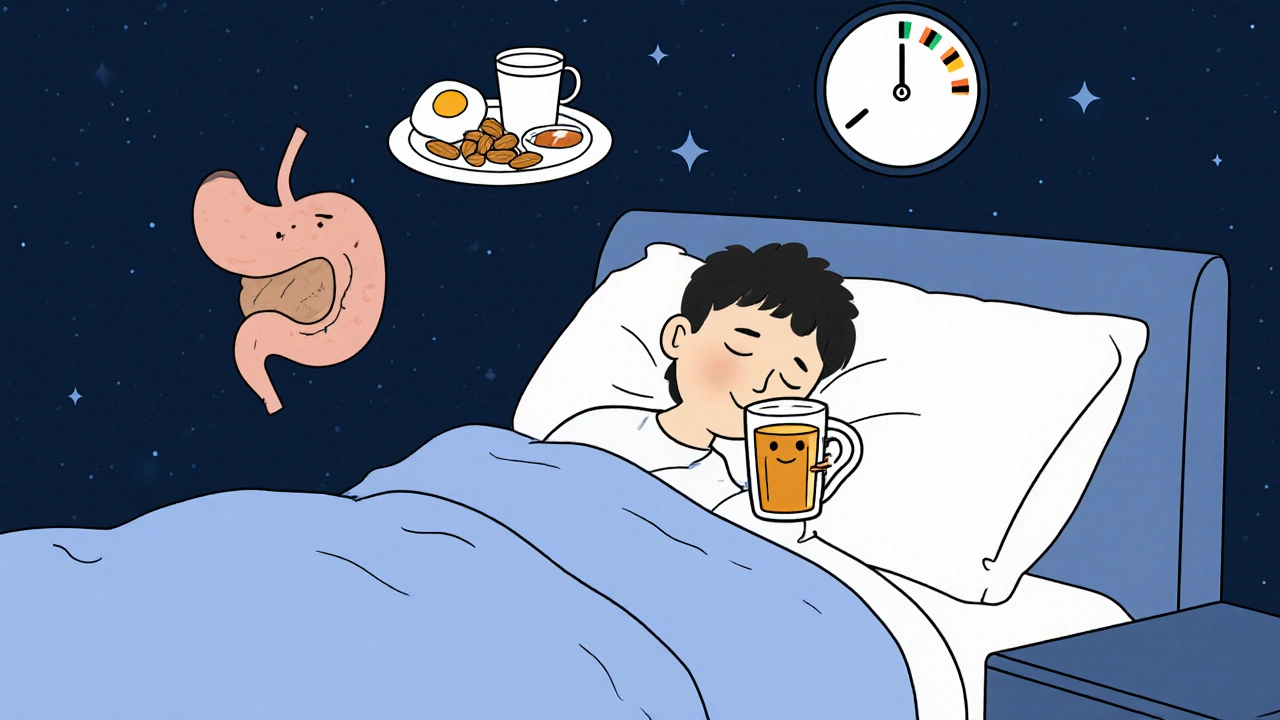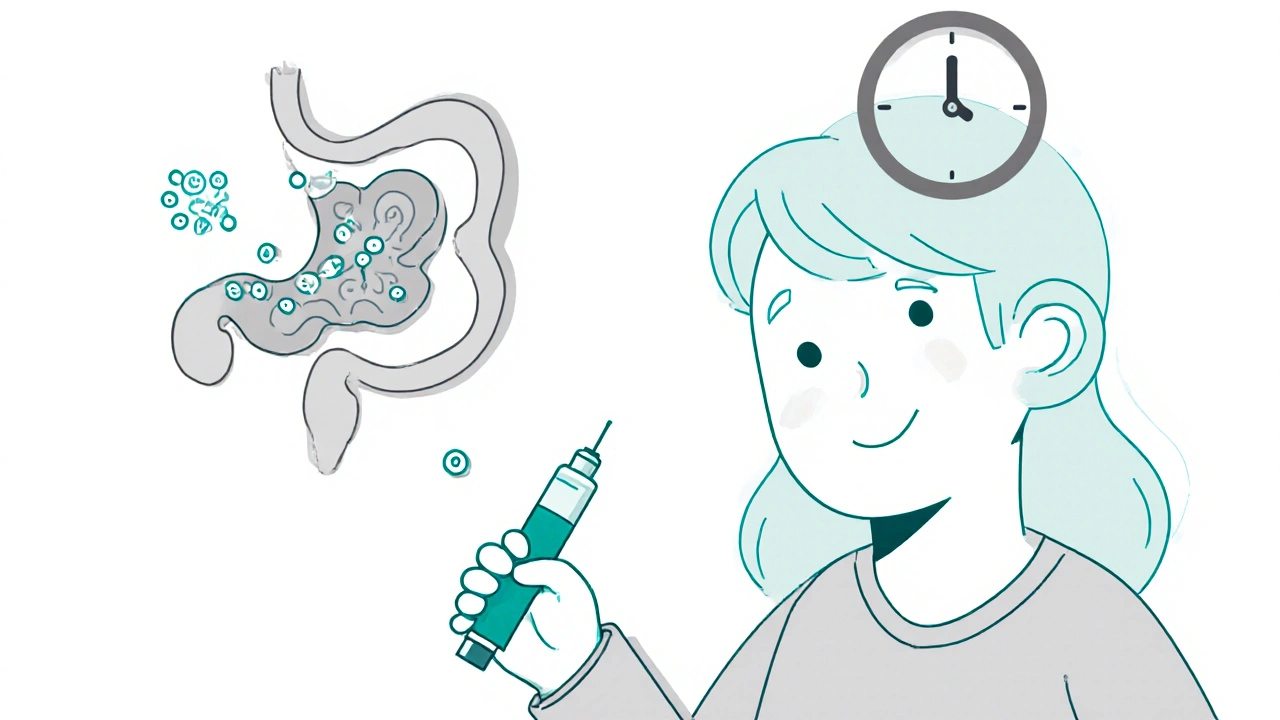When you start a GLP-1 medication like Wegovy, Ozempic, or Mounjaro for weight loss, the goal is clear: lose weight, feel better, and improve your health. But for many, the first real challenge isn’t the scale-it’s the nausea. It hits hard, often right after the first dose, and it’s enough to make people quit before they even see results. The truth? Nausea is the most common side effect, but it’s also the most manageable-if you know how.
Why GLP-1 Medications Cause Nausea
GLP-1 medications work by slowing down how fast your stomach empties. That’s not a bug-it’s the whole point. Slower digestion means you feel full longer, eat less, and your blood sugar stays steadier. But that same mechanism is why your stomach rebels. When food sits longer, your body sends signals that trigger nausea. It’s not an allergic reaction. It’s not your fault. It’s just how the medicine works.Studies show 20% to 45% of people experience nausea, depending on the dose. At the lowest starting dose, it’s usually mild. By the time you hit the full dose-2.4 mg for Wegovy, 15 mg for Mounjaro-up to half of users report nausea. But here’s what most people don’t tell you: it gets better. The Mayo Clinic found that nausea drops significantly after 2 to 4 weeks at each dose level. Most users say it fades by the time they reach their maintenance dose.
How Dosing Works-And Why It’s Designed This Way
These medications don’t start at full strength. They’re built to creep up slowly. That’s not just caution-it’s science.Here’s what the real dosing schedule looks like:
- Wegovy (weight loss): Starts at 0.25 mg once a week. After 4 weeks, it goes to 0.5 mg. Then 1 mg, then 1.7 mg, and finally 2.4 mg at week 17. That’s over four months just to get to the highest dose.
- Ozempic (diabetes, same drug): Starts at 0.25 mg, moves to 0.5 mg after 4 weeks, then 1 mg. The max is 2 mg.
- Mounjaro (tirzepatide): Begins at 2.5 mg, then increases every 4 weeks: 5 mg, 7.5 mg, 10 mg, and up to 15 mg. That’s about 20 weeks to reach max.
- Victoza (liraglutide): Starts at 0.6 mg daily, then increases to 1.2 mg or 1.8 mg after a week.
This slow ramp-up isn’t optional. It’s what keeps people on the medication. A Cleveland Clinic survey found that 63% of users who took their dose at bedtime reported less nausea. Why? Because you’re asleep when the worst of it hits. The body also has time to adjust overnight.
Some people try to speed up the process. Don’t. Jumping ahead increases nausea risk by 3x, according to a 2023 study in Obesity Medicine. Stick to the schedule-even if you feel fine. Your stomach needs the time.
Real Ways to Reduce Nausea (Backed by Users and Doctors)
You don’t have to suffer through this. There are proven strategies that work.- Eat smaller meals, more often. Three big meals overwhelm your slowed stomach. Try five small ones. A handful of almonds, a boiled egg, Greek yogurt-these are easier to digest.
- Avoid greasy, fried, or ultra-processed foods. Fat takes longer to digest, and your stomach already can’t move things quickly. Pizza, fries, and pastries will make nausea worse.
- Stay hydrated-but sip slowly. Chugging water right after your shot makes nausea worse. Sip water throughout the day. Add lemon or ginger for taste. Ginger tea or ginger chews helped 78% of users in a National Obesity Society survey.
- Take your dose at night. As mentioned, this isn’t a myth. A 2023 survey from Intermountain Healthcare showed 63% of patients had less nausea when dosing at bedtime.
- Don’t lie down right after eating. Wait 30 to 45 minutes. Gravity helps. Walking gently for 10 minutes after a meal can also help digestion.
- Track your symptoms. Keep a simple log: date, dose, what you ate, how nauseous you felt (1-10 scale). You’ll spot patterns. Maybe it’s only after pasta. Or after coffee. Adjust accordingly.
One Reddit user, WeightLossWarrior87, wrote: “Weeks 1-4 were brutal. Daily nausea. By week 3 at 0.5 mg, I switched to smaller meals and ginger tea. It went from ‘I can’t leave the house’ to ‘I’m fine.’” That’s not luck. That’s strategy.

When to Pause-or Stop-Dosing
Nausea is normal. Constant vomiting, dizziness, or severe pain? Not okay.Here’s when to call your doctor:
- Nausea lasts more than 2 weeks at the same dose
- You’re vomiting more than once a day
- You can’t keep fluids down
- You lose more than 5% of your body weight in a week (this isn’t normal)
- You feel faint or have rapid heartbeat
Some doctors will pause your dose for a week if nausea is severe. Others will drop you back to the previous level. That’s not failure-it’s smart adjustment. The goal isn’t to push through pain. It’s to find the dose that works for your body.
According to Dr. David Ludwig from Harvard, “Persistent nausea isn’t a sign you’re doing it right-it’s a sign you need to adjust.” Don’t feel guilty for needing to slow down.
What Happens If You Quit Too Soon?
This is the biggest mistake people make.Research from the Obesity Action Coalition shows that 89% of people who stuck through the first 8 weeks of nausea lost at least 5% of their body weight. Only 47% of those who quit because of nausea did. That’s nearly double the success rate.
And here’s the kicker: weight loss doesn’t start right away. In the first 8 weeks, most people lose only 2-3% of their weight. The real drop-10%, 15%, even 20%-happens after 6 months. If you quit because of nausea at week 6, you’re quitting before the payoff.
Think of it like starting a new workout. The first week hurts. You’re sore. You want to quit. But if you keep going, your body adapts. The same thing happens with GLP-1 meds.
Other Side Effects to Watch For
Nausea is the main one, but it’s not the only one.- Constipation or diarrhea: Common. Drink more water. Eat fiber-rich foods like oats, beans, apples.
- Headaches: Usually mild. Often tied to dehydration.
- Fatigue: Can happen as your body adjusts. Rest. Don’t push through exhaustion.
- Low blood sugar: Rare if you’re not on diabetes meds. But if you’re also taking insulin or sulfonylureas, talk to your doctor. Doses may need adjusting.
There’s also a rare but serious risk: thyroid tumors in animal studies. No human cases have been confirmed, but the FDA requires a warning. If you have a personal or family history of medullary thyroid cancer, talk to your doctor before starting.
Support Is Out There-Use It
You’re not alone. There are real communities helping people through this.- Novo Nordisk’s Wegovy Support Program offers free coaching, injection training, and meal planning tools.
- Eli Lilly’s Mounjaro Care provides nurse support and financial help for those without insurance.
- Reddit’s r/semaglutide has over 156,000 members sharing daily tips. Search “nausea” or “dosing” and you’ll find hundreds of real stories.
- TikTok has thousands of videos with #GLP1SideEffects. Most show practical fixes: meal prep ideas, ginger remedies, how to inject without pain.
Telehealth clinics like Ro, Hims, and Obesity Medicine Specialists now offer GLP-1 coaching. Many include nutritionists who specialize in these meds.
What’s Next? Oral GLP-1s and More Options
The future is getting easier. Novo Nordisk is launching an oral version of semaglutide in 2025. Early data shows it causes 30% less nausea than the injectable. That’s huge.Meanwhile, the market is expanding. Zepbound (tirzepatide for weight loss) got FDA approval in late 2023. It’s slightly more effective than Wegovy-average 20.9% weight loss in trials-but also has slightly higher nausea rates.
Cost is still a barrier. Without insurance, it’s $9,000 to $13,000 a year. But 32% of Fortune 500 companies now cover it for weight management, up from 9% in 2021. Check with your employer.
And here’s something powerful: the 2023 SELECT trial showed semaglutide reduced heart attacks, strokes, and heart-related deaths by 20% in people with obesity-even without diabetes. That’s not just weight loss. That’s life-saving.
Final Thought: This Isn’t a Quick Fix. It’s a Lifestyle Shift.
GLP-1 medications aren’t magic pills. They’re tools. And tools only work if you use them right. Nausea is a hurdle, not a dealbreaker. Dosing schedules are designed to protect you, not punish you. And the results? They’re real.People are losing 15, 20, even 25 pounds. They’re reversing prediabetes. They’re sleeping better. They’re walking up stairs without getting winded. But none of that happens if you quit because of nausea in week 5.
Stick with it. Adjust. Ask for help. You’re not failing. You’re learning.

All Comments
Nosipho Mbambo November 20, 2025
Ugh, I tried this stuff… and honestly? It felt like my stomach was holding a grudge. I didn’t quit, but I cried through week 3. Ginger tea saved me. Also, why is everyone acting like this is normal? It’s not. It’s just… tolerated.
Katie Magnus November 21, 2025
Wow. So you’re telling me the solution to nausea is… eating almonds? And drinking water? I mean, I’m shocked. Who knew food and hydration could help? Next you’ll say exercise is good for you. 😴
King Over November 22, 2025
took mine at night. nausea gone by week 2. no big deal. just don't eat pizza
Johannah Lavin November 23, 2025
Y’ALL. I was SO scared to start this. I cried before my first injection. But after switching to bedtime dosing + ginger chews + tiny meals? I lost 18 lbs in 4 months. 🥹 I’m not the same person. And yes, it sucked at first. But you’re not broken if it’s hard. You’re human. And you’re doing better than you think 💪❤️
Ravinder Singh November 25, 2025
Bro, this is the most practical guide I’ve ever read on GLP-1s. Seriously. I’m from India, and we don’t talk about this stuff openly. But I started Mounjaro last month - nausea was brutal at first. I tried the ginger tea, small meals, and bedtime dosing like you said. By week 5, I barely noticed it. Also, walking after meals? Game changer. You’re not just giving info - you’re giving hope. Thank you 🙏
Russ Bergeman November 26, 2025
Wait, so… you’re saying nausea is ‘normal’? That’s not normal. That’s your body screaming. And why are you recommending ginger? Like, is this a 1990s home remedy blog? Also, 63% of people? That means 37% still suffered. You’re gaslighting people into suffering. 🤦♂️
Dana Oralkhan November 27, 2025
To the person above - I get it. It feels invalidating when your pain is called ‘normal.’ I was there. But the thing is - it’s not about dismissing the nausea. It’s about knowing it’s temporary, and that there are real, simple ways to make it bearable. I lost my mom to diabetes. I didn’t want to end up like her. So I stuck with it, even when I felt like garbage. It wasn’t easy. But it was worth it. You’re not alone.
Jeremy Samuel November 28, 2025
oral glp-1s in 2025? pfft. bet they’ll be $15k a year and still make you puke. just sayin. also who even uses reddit anymore? 🤷♂️